The Design and Processor-In-The-Loop Implementation of a Super-Twisting Control Algorithm Based on a Luenberger Observer for a Seamless Transition between Grid-Connected and Stand-Alone Modes in Microgrids
Abstract
1. Introduction
- The design of an ST-SMC for a three-phase inverter to provide a proper and seamless transition from the grid-connected mode to islanded mode.
- The adoption the digital Luenberger observer (DLO) to estimate the inverter-side current of the system under study will reduce the prep time of the disconnected controller.
- The achievement of a quicker and more effective grid synchronization without losing the phase-angle and frequency stability in both the GC and SA modes.
- A PIL validation to assess the proposed transition technique’s efficiency during the GC and SA modes.
2. Structure of Three-Phase VSI Operating in GC and SA Modes with the Proposed Controller
- A digital Luenberger-observer-based-estimation of the inverter-side currents, , which adopts the capacitor actual voltage, , and the inverter-side voltage, , as inputs.
- The regulation of the estimated current in the dq frame, , to the current references, , generated by a power controller according to the desired real and reactive powers ( and ). This current control mode is considered for the case of the GC mode of operation.
- Under SA operation, a voltage control mode is adopted, in which the dq capacitor voltages, and , are adjusted to the voltage reference, , provided by the droop control and zero, respectively. This adopted control scheme includes a droop controller with a power calculation unit and a double-loop inner controller, which includes an internal sensorless current controller based on a PI compensator and an outer voltage control loop based on a super-twisting controller. The super-twisting-based-voltage control is needed to keep the system stable and the performance adequate at the transition instant when the grid parameters vary.
- A phase-locked loop (PLL) synchronization algorithm is required to synchronize the output inverter with the utility grid, as seen in Figure 1b. This stage should be capable of extracting and adjusting the frequency of the output inverter.
Modelling of the System under Study
3. Proposed Control Scheme for Both GC and SA Modes of Operation
3.1. Proposed Current Sensorless Control for GC Operating Mode
3.1.1. Digital Luenberger Observer
Construction and Observability Analysis of DLO
Observer Gain Design
3.2. Proposed Control Scheme Based on a Super-Twisting Algorithm for SA Mode
3.2.1. Droop Control Strategy
3.2.2. Outer Loop Voltage Regulation Based on Super-Twisting Algorithm
4. Simulation Results and PIL Validation
4.1. Simulation Results and Discussion
4.2. PIL Implementation Using DSP Board TMS32F28335
5. Conclusions
Author Contributions
Funding
Data Availability Statement
Conflicts of Interest
References
- Chaturvedi, S.; Wang, M.; Fan, Y.; Fulwani, D.; Hollweg, G.V.; Khan, S.A.; Su, W. Control Methodologies to Mitigate and Regulate Second-Order Ripples in DC–AC Conversions and Microgrids: A Brief Review. Energies 2023, 16, 817. [Google Scholar] [CrossRef]
- Amer, A.; Shaban, K.; Gaouda, A.; Massoud, A. Home energy management system embedded with a multi-objective demand response optimization model to benefit customers and operators. Energies 2021, 14, 257. [Google Scholar] [CrossRef]
- Anglani, N.; Di Salvo, S.R.; Oriti, G.; Julian, A.L. Steps towards Decarbonization of an Offshore Microgrid: Including Renewable, Enhancing Storage and Eliminating Need of Dump Load. Energies 2023, 16, 1411. [Google Scholar] [CrossRef]
- Khan, M.A.; Kurukuru, V.B.; Haque, A.; Mekhilef, S. Islanding classification mechanism for grid-connected photovoltaic systems. IEEE J. Emerg. Sel. Top. Power Electron. 2020, 9, 1966–1975. [Google Scholar] [CrossRef]
- Ochs, D.S.; Mirafzal, B.; Sotoodeh, P. A method of seamless transitions between grid-tied and stand-alone modes of operation for utility-interactive three-phase inverters. IEEE Trans. Ind. Appl. 2013, 50, 1934–1941. [Google Scholar] [CrossRef]
- Mahmoud, A.A.; Hafez, A.A.; Yousef, A.M.; Gaafar, M.A.; Orabi, M.; Ali, A.F. Fault-tolerant modular multilevel converter for a seamless transition between stand-alone and grid-connected microgrid. IET Power Electron. 2023, 16, 11–25. [Google Scholar] [CrossRef]
- Karimi-Ghartemani, M.; Khajehoddin, S.A.; Piya, P.; Ebrahimi, M. Universal controller for three-phase inverters in a microgrid. IEEE J. Emerg. Sel. Top. Power Electron. 2016, 4, 1342–1353. [Google Scholar] [CrossRef]
- Yi, Z.; Dong, W.; Etemadi, A.H. A unified control and power management scheme for PV-battery-based hybrid microgrids for both grid-connected and islanded modes. IEEE Trans. Smart Grid 2017, 9, 5975–5985. [Google Scholar] [CrossRef]
- Shi, K.; Zhou, G.; Xu, P.; Ye, H.; Tan, F. The integrated switching control strategy for grid-connected and islanding operation of micro-grid inverters based on a virtual synchronous generator. Energies 2018, 11, 1544. [Google Scholar] [CrossRef]
- Lim, K.; Choi, J. Seamless grid synchronization of a proportional+ resonant control-based voltage controller considering non-linear loads under islanded mode. Energies 2017, 10, 1514. [Google Scholar] [CrossRef]
- Lim, J.U.; Kwon, I.S.; Kim, H.W.; Cho, K.Y. Seamless Transfer Algorithm of AC Microgrid Inverter Compensating Load Current for Weak Grid. Energies 2019, 12, 728. [Google Scholar] [CrossRef]
- Teng, Q.; Xu, D.; Yang, W.; Li, J.; Shi, P. Neural network-based integral sliding mode backstepping control for virtual synchronous generators. Energy Rep. 2021, 7, 1–9. [Google Scholar] [CrossRef]
- Arafat, M.N.; Palle, S.; Sozer, Y.; Husain, I. Transition control strategy between standalone and grid-connected operations of voltage-source inverters. IEEE Trans. Ind. Appl. 2012, 48, 1516–1525. [Google Scholar] [CrossRef]
- Vilhena, N.; Roncero-Clemente, C.; Delgado-Gomes, V.; Fernão Pires, V.; Martins, J.F. Energy router for SC: GC, SA and transition mode controls. IET Renew. Power Gener. 2020, 14, 914–924. [Google Scholar] [CrossRef]
- Lim, K.; Choi, J. PR based indirect current control for seamless transfer of grid-connected inverter. In Proceedings of the 2016 IEEE 8th International Power Electronics and Motion Control Conference (IPEMC-ECCE Asia), Hefei, China, 22–26 May 2016; pp. 3749–3755. [Google Scholar]
- Benadli, R.; Bjaoui, M.; Khiari, B.; Sellami, A. Sliding Mode Control of Hybrid Renewable Energy System Operating in Grid Connected and Stand-Alone Mode. Power Electron. Drives 2021, 6, 144–166. [Google Scholar] [CrossRef]
- Mohamed, Y.A.R.I.; Radwan, A.A. Hierarchical control system for robust microgrid operation and seamless mode transfer in active distribution systems. IEEE Trans. Smart Grid 2011, 2, 352–362. [Google Scholar] [CrossRef]
- Canciello, G.; Russo, A.; Guida, B.; Cavallo, A. Supervisory control for energy storage system onboard aircraft. In Proceedings of the 2018 IEEE International Conference on Environment and Electrical Engineering and 2018 IEEE Industrial and Commercial Power Systems Europe (EEEIC/I&CPS Europe), Palermo, Italy, 12–15 June 2018; pp. 1–6. [Google Scholar]
- Li, X.; Zhang, H.; Shadmand, M.B.; Balog, R.S. Model predictive control of a voltage-source inverter with seamless transition between islanded and grid-connected operations. IEEE Trans. Ind. Electron. 2017, 64, 7906–7918. [Google Scholar] [CrossRef]
- Choe, J.M.; Byen, B.J.; Moon, S.; Lai, J.S. A capacitor current control for stand-alone inverters using an inductor current observer. In Proceedings of the 2015 IEEE 9th International Conference on Power Electronics and ECCE Asia (ICPE-ECCE Asia), Seoul, Republic of Korea, 1–5 June 2015; pp. 1143–1148. [Google Scholar]
- Latham, J.; Mohebbi, M.; McIntyre, M.L. Output feedback control of a single phase voltage source inverter utilizing a variable structure observer. In Proceedings of the 2017 IEEE American Control Conference (ACC), Seattle, WA, USA, 24–26 May 2017; pp. 4081–4086. [Google Scholar]
- Lou, G.; Gu, W.; Wang, J.; Wang, J.; Gu, B. A unified control scheme based on a disturbance observer for seamless transition operation of inverter-interfaced distributed generation. IEEE Trans. Smart Grid 2017, 9, 5444–5454. [Google Scholar] [CrossRef]
- Zhang, Z.; Wu, J.; Zheng, L.; Xie, D.; Tang, X. An Inductor Current Sensorless Control Strategy Based on Modified VSG Method for Single-Phase Microgrid Application with Seamless Transfer Capability. Front. Energy Res. 2021, 9, 575. [Google Scholar] [CrossRef]
- Cheng, C.; Xie, S.; Xu, J.; Qian, Q. State-and-disturbance-observer-based current control scheme for LCL-filtered single-phase grid-tied inverters under nonideal conditions. IEEE J. Emerg. Sel. Top. Power Electron. 2021, 10, 336–348. [Google Scholar] [CrossRef]
- Vegunta, S.C.; Higginson, M.J.; Kenarangui, Y.E.; Li, G.T.; Zabel, D.W.; Tasdighi, M.; Shadman, A. AC microgrid protection system design challenges—A practical experience. Energies 2021, 14, 2016. [Google Scholar] [CrossRef]
- Hren, A.; Mihalič, F. An improved SPWM-based control with over-modulation strategy of the third harmonic elimination for a single-phase inverter. Energies 2018, 11, 881. [Google Scholar] [CrossRef]
- Guo, B.; Su, M.; Wang, H.; Tang, Z.; Liao, Y.; Zhang, L.; Shi, S. Observer-based second-order sliding mode control for grid-connected VSI with LCL-type filter under weak grid. Electr. Power Syst. Res. 2020, 183, 106270. [Google Scholar] [CrossRef]
- Aillane, A.; Dahech, K.; Damak, T.; Chouder, A.; Hadjkaddour, A.; Cherifi, A. An Observer-Based Inductor Current Control for a Bifunctional Three-Phase DG-Inverter. In Proceedings of the 2022 IEEE 21st international Conference on Sciences and Techniques of Automatic Control and Computer Engineering (STA), Sousse, Tunisia, 19–21 December 2022; pp. 566–571. [Google Scholar]
- Khan, M.A.; Haque, A.; Kurukuru, V.S.B. Droop based Low voltage ride through implementation for grid integrated photovoltaic system. In Proceedings of the 2019 IEEE International Conference on Power Electronics, Control and Automation (ICPECA), New Delhi, India, 16–17 November 2019; pp. 1–5. [Google Scholar]
- Hmad, J.; Houari, A.; Trabelsi, H.; Machmoum, M. Fuzzy logic approach for smooth transition between grid-connected and stand-alone modes of three-phase DG-inverter. Electr. Power Syst. Res. 2019, 175, 105892. [Google Scholar] [CrossRef]
- Russo, A.; Canciello, G.; Cavallo, A. Generalized super-twisting control of a dual active bridge for more electric aircraft. In Proceedings of the 2021 European Control Conference (ECC), Delft, The Netherlands, 29 June–2 July 2021; pp. 1610–1615. [Google Scholar]
- Ammar, A.; Benakcha, A.; Bourek, A. Closed loop torque SVM-DTC based on robust super twisting speed controller for induction motor drive with efficiency optimization. Int. J. Hydrogen Energy 2017, 42, 17940–17952. [Google Scholar] [CrossRef]
- Rashed, M.; Goh, K.B.; Dunnigan, M.W.; MacConnell, P.F.A.; Stronach, A.F.; Williams, B.W. Sensorless second-order sliding-mode speed control of a voltage-fed induction-motor drive using nonlinear state feedback. IEE Proc. Electr. Power Appl. 2005, 152, 1127–1136. [Google Scholar] [CrossRef]
- Levant, A. Higher-order sliding modes, differentiation and output-feedback control. Int. J. Control 2003, 76, 924–941. [Google Scholar] [CrossRef]
- Bendjeddou, Y.; Deboucha, A.; Bentouhami, L.; Merabet, E.; Abdessemed, R. Super twisting sliding mode approach applied to voltage orientated control of a stand-alone induction generator. Prot. Control Mod. Power Syst. 2021, 6, 18. [Google Scholar] [CrossRef]
- Deffaf, B.; Hamoudi, F.; Debdouche, N.; Amor, Y.A.; Medjmadj, S. Super-twisting Sliding Mode Control for a Multifunctional Double Stage Grid-connected Photovoltaic System. Adv. Electr. Electron. Eng. 2022, 20, 240–249. [Google Scholar] [CrossRef]
- Vardhan, H.; Akin, B.; Jin, H. A low-cost, high-fidelity processor-in-the loop platform: For rapid prototyping of power electronics circuits and motor drives. IEEE Power Electron. Mag. 2016, 3, 18–28. [Google Scholar] [CrossRef]
- Çelik, D. Lyapunov based harmonic compensation and charging with three phase shunt active power filter in electrical vehicle applications. Int. J. Electr. Power Energy Syst. 2022, 136, 107564. [Google Scholar] [CrossRef]
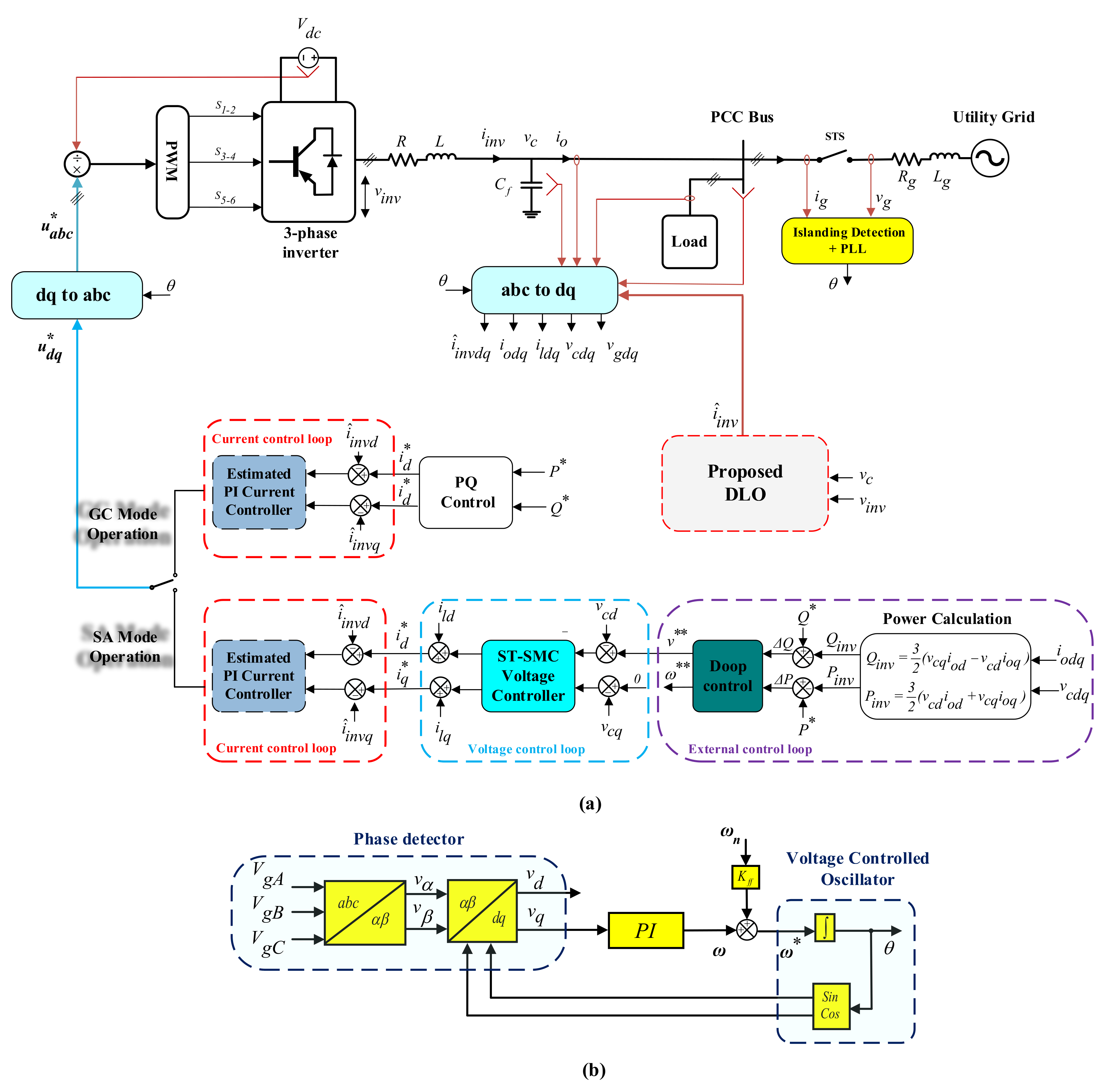

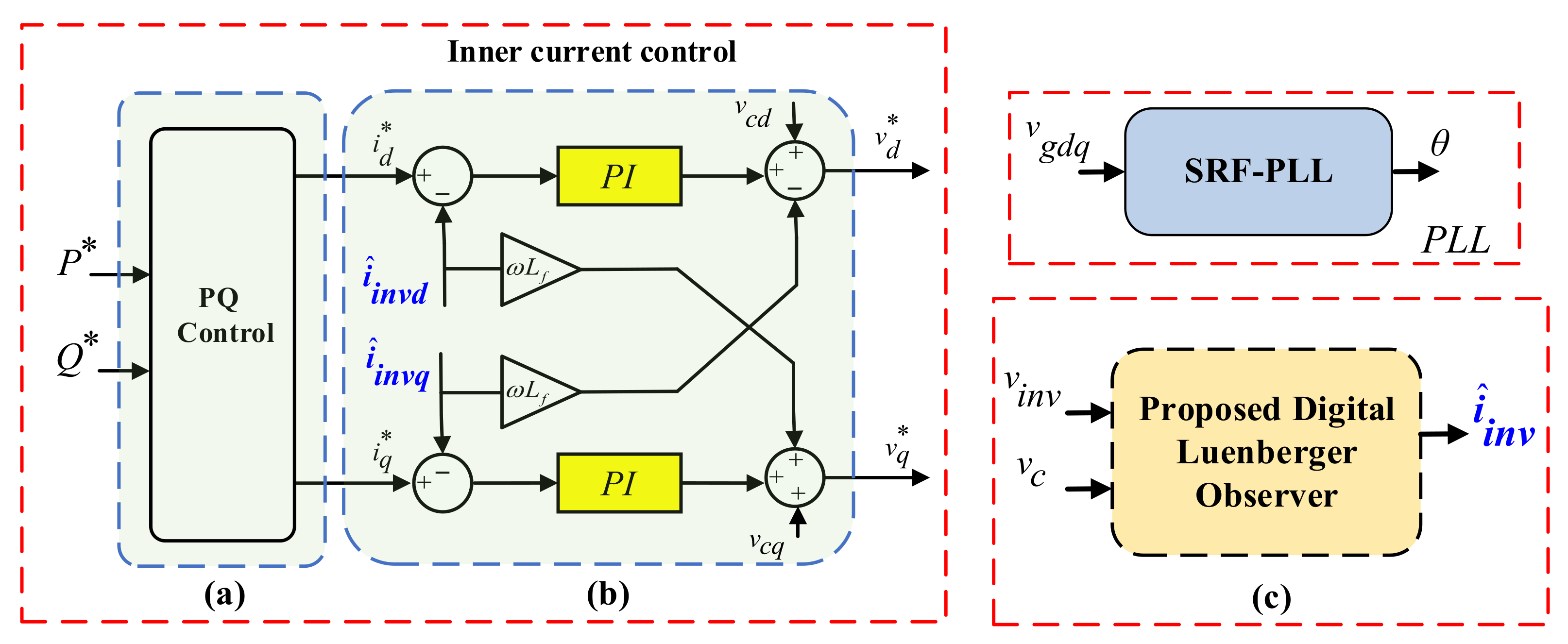

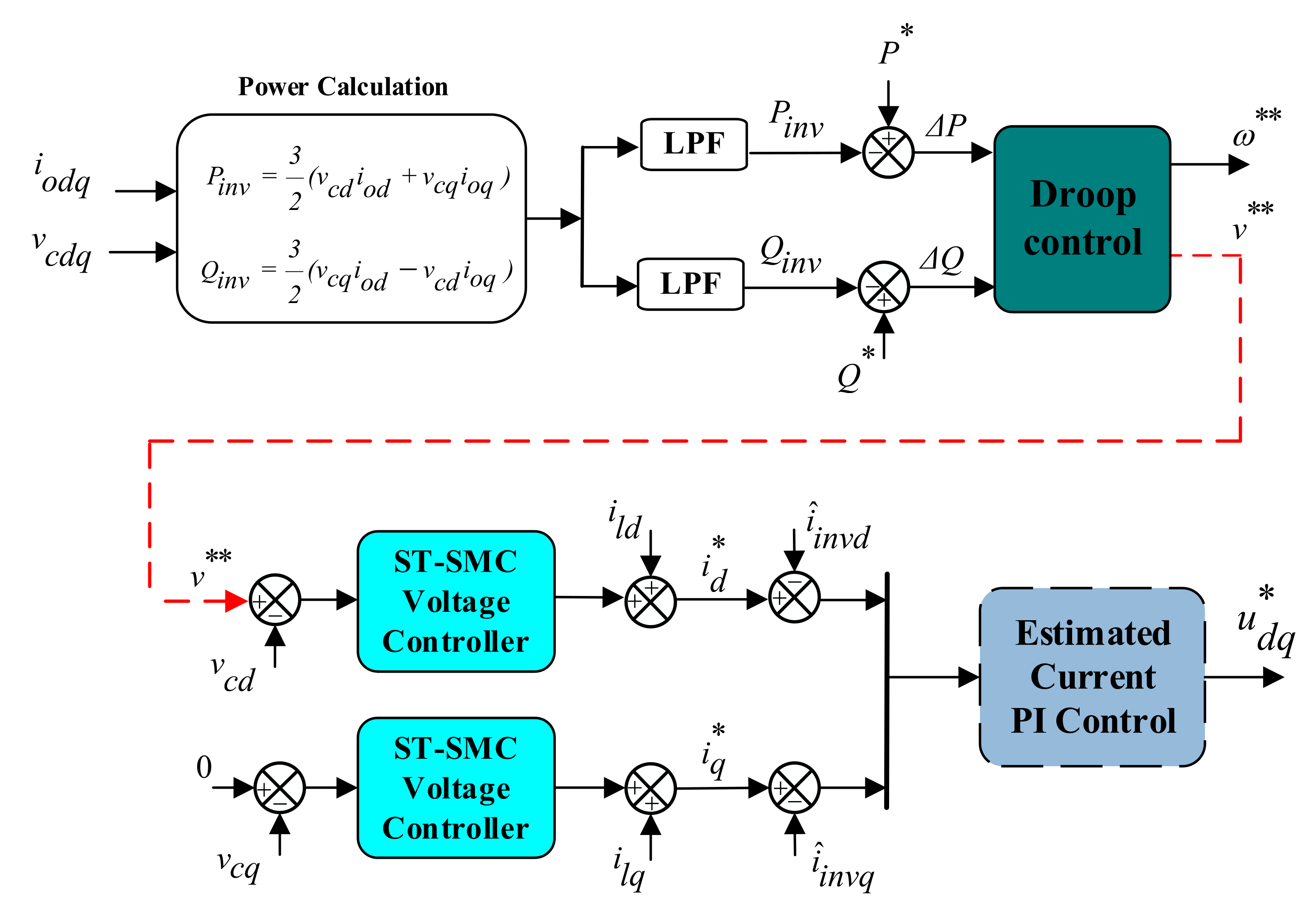
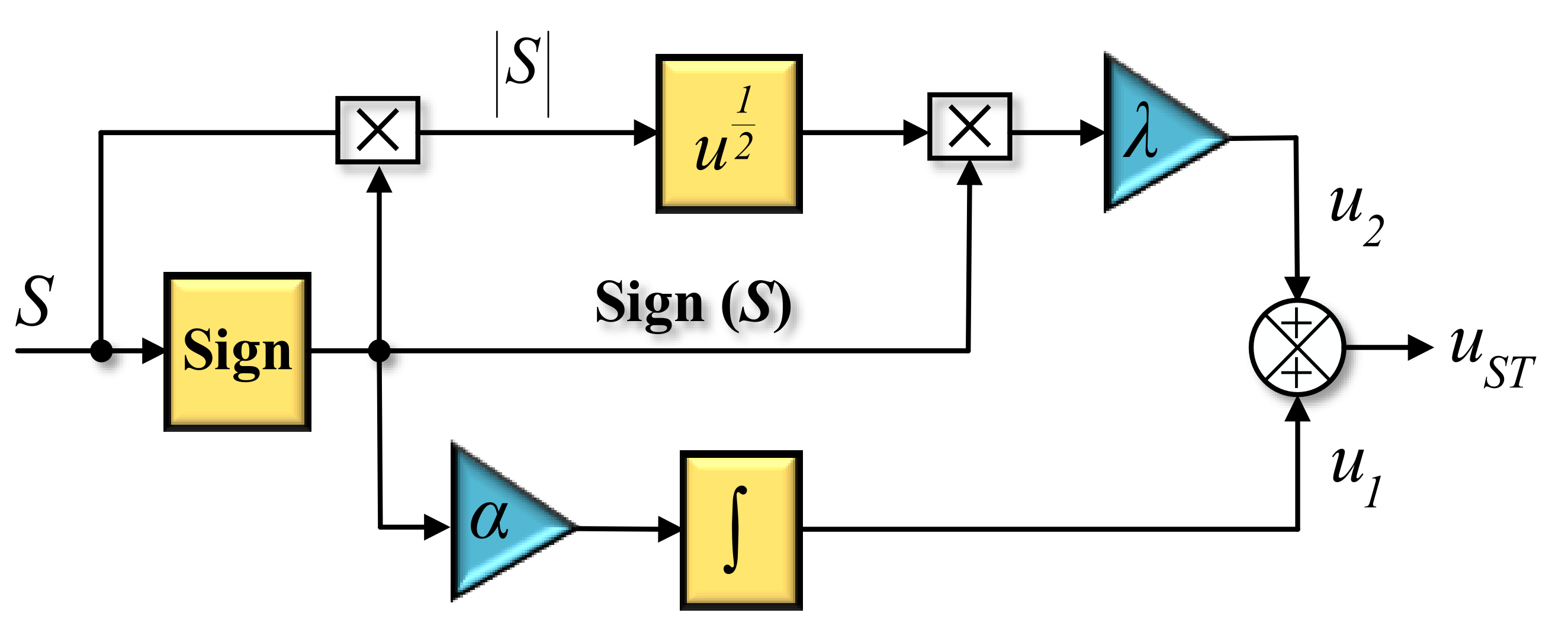
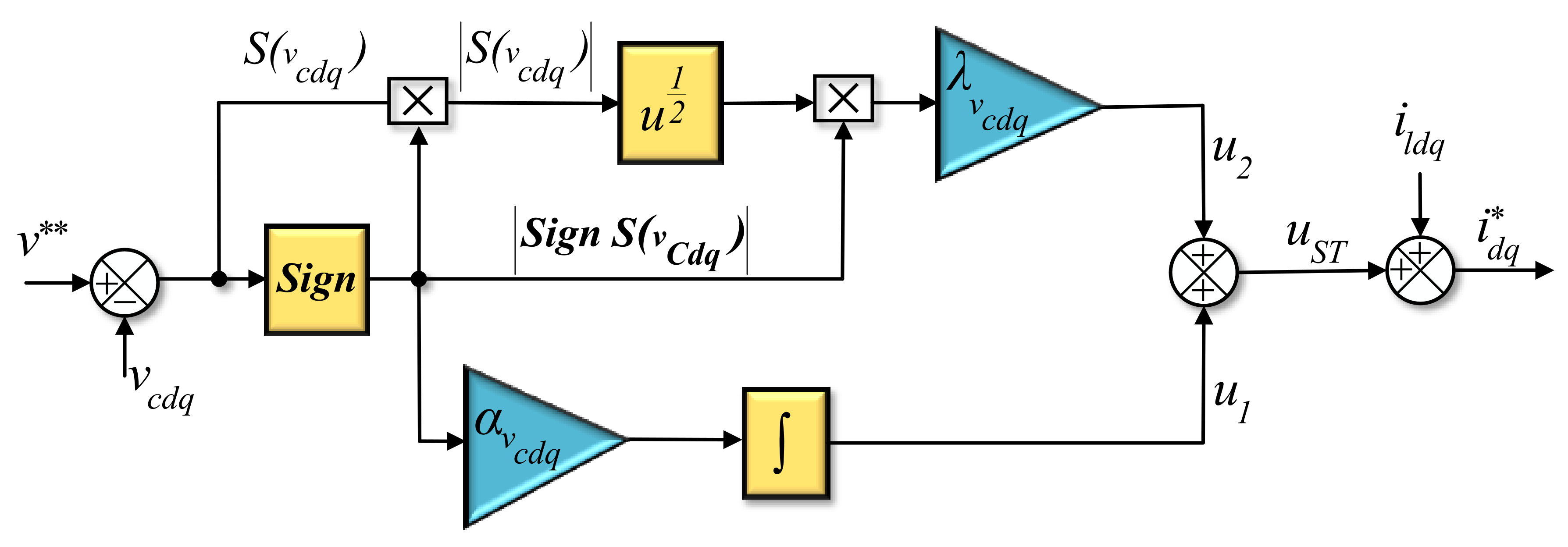
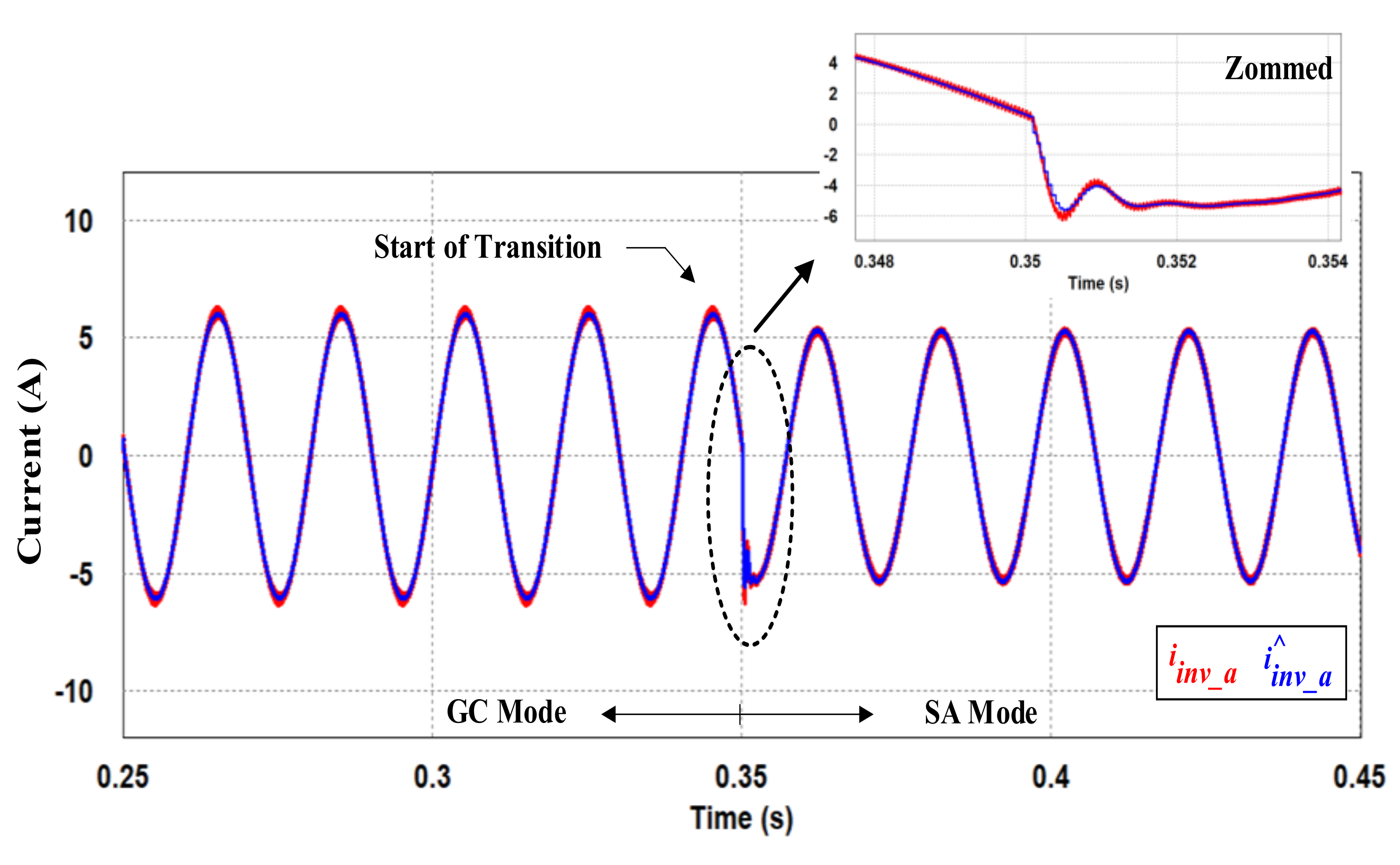
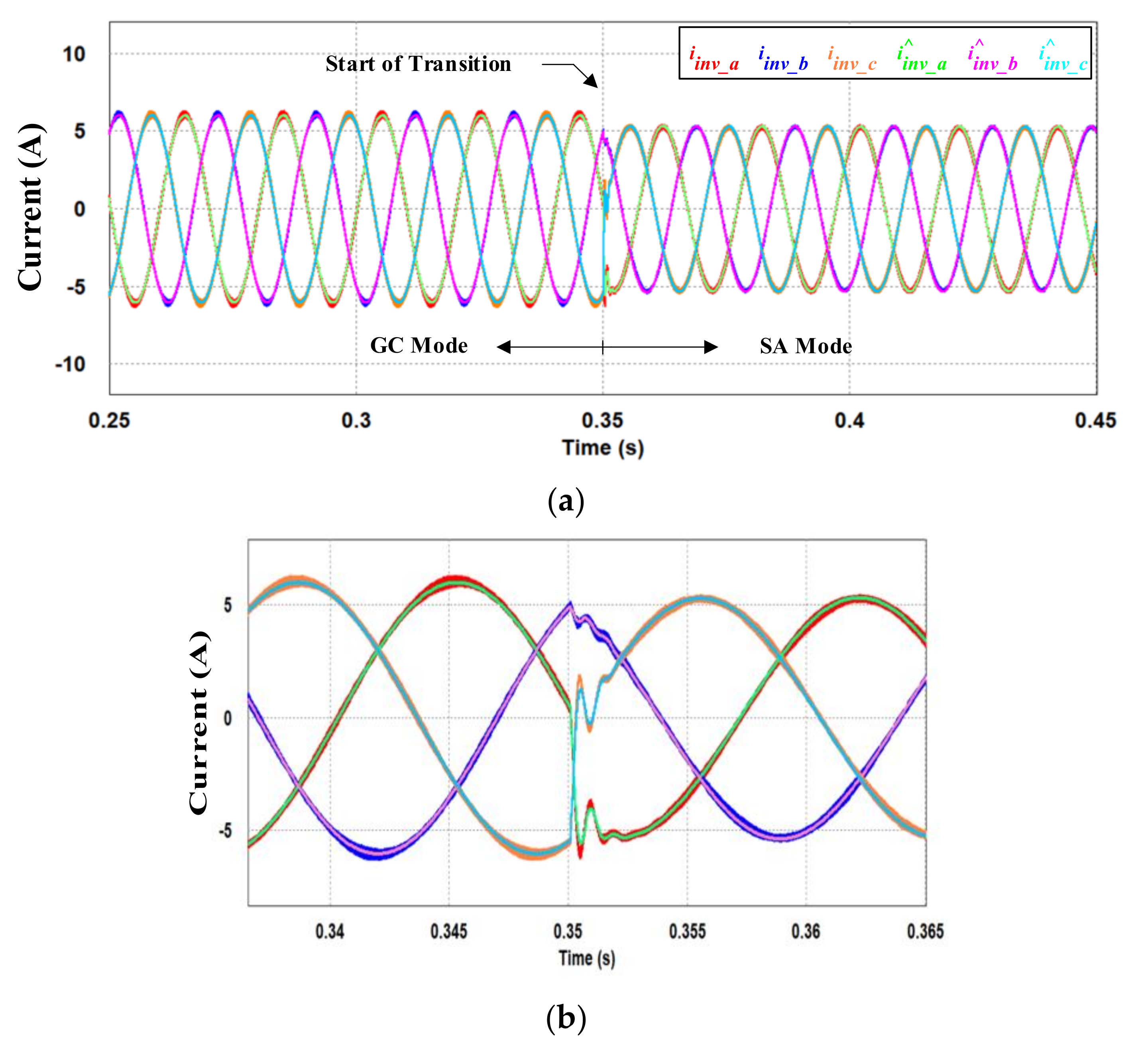
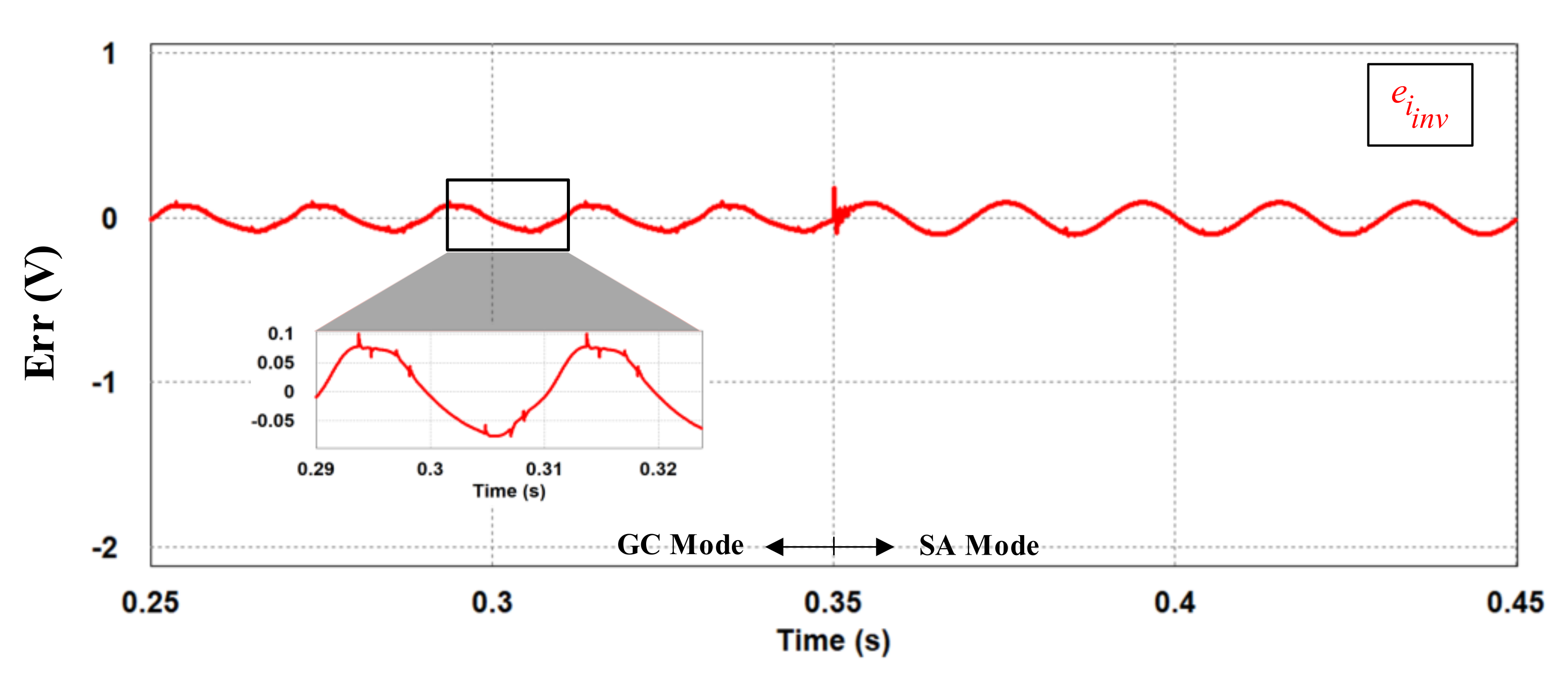
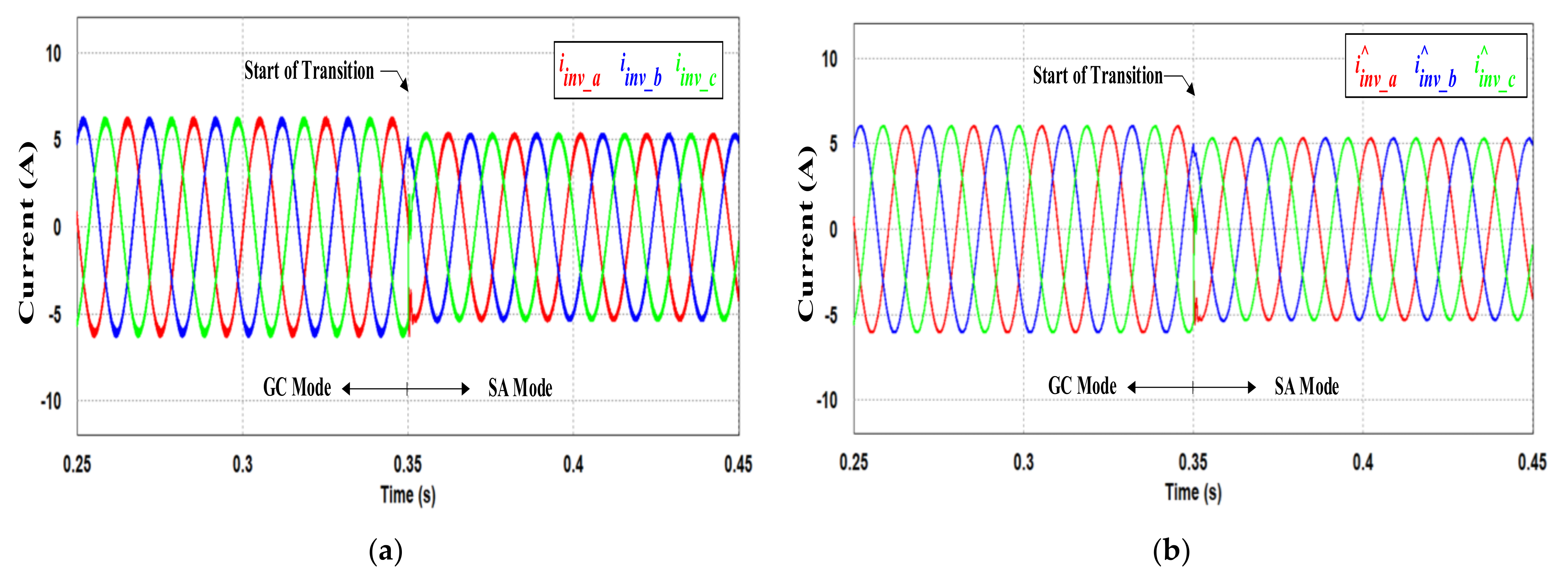



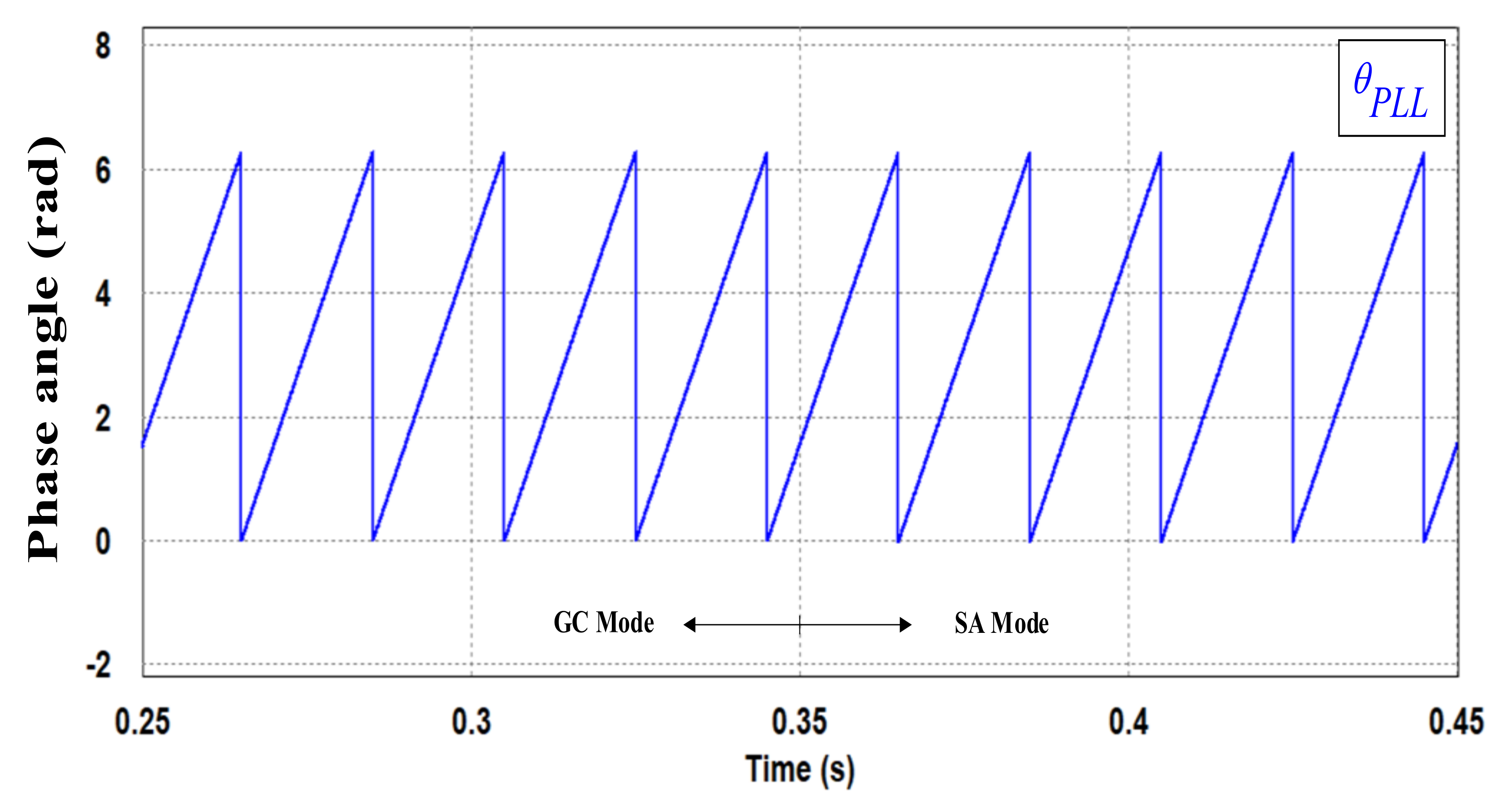
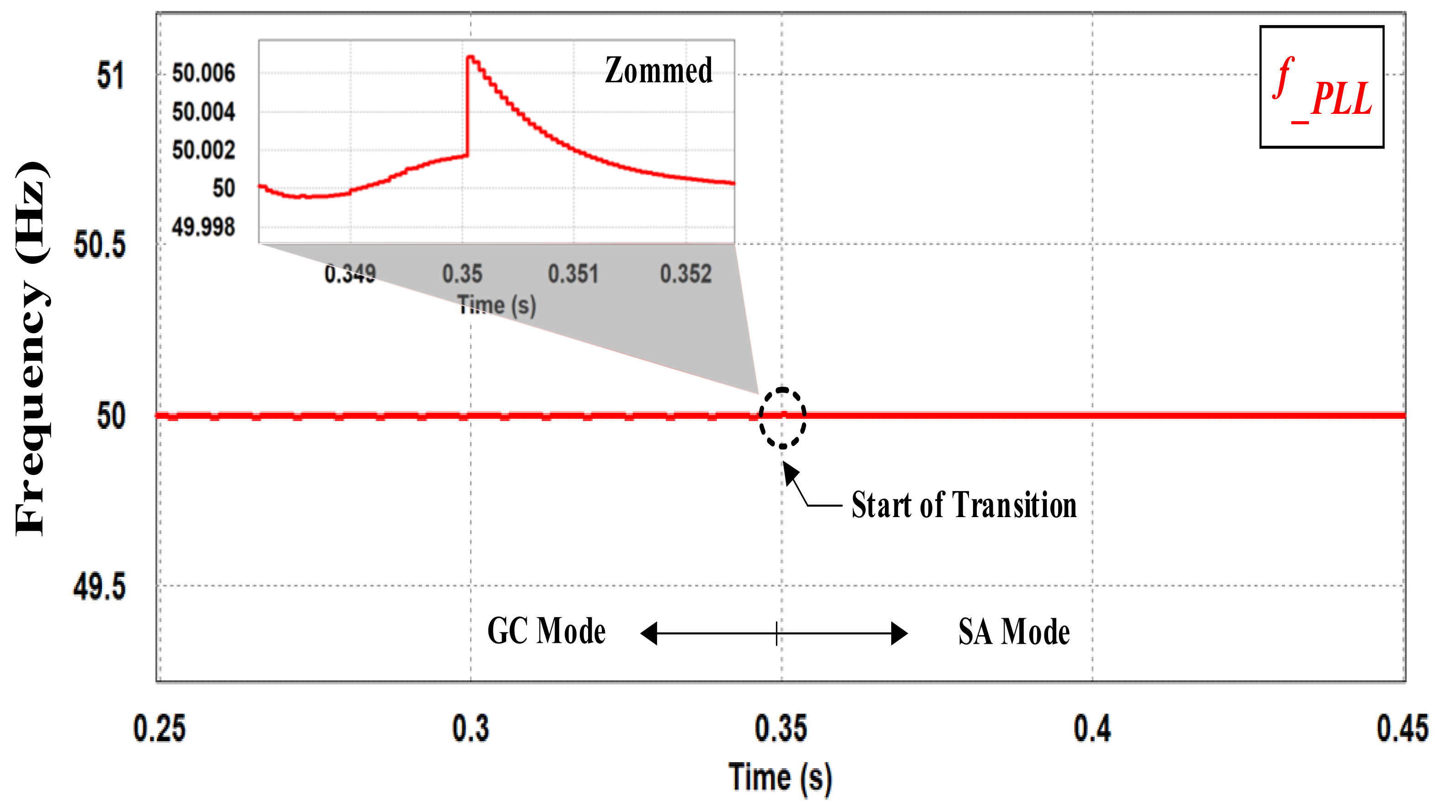

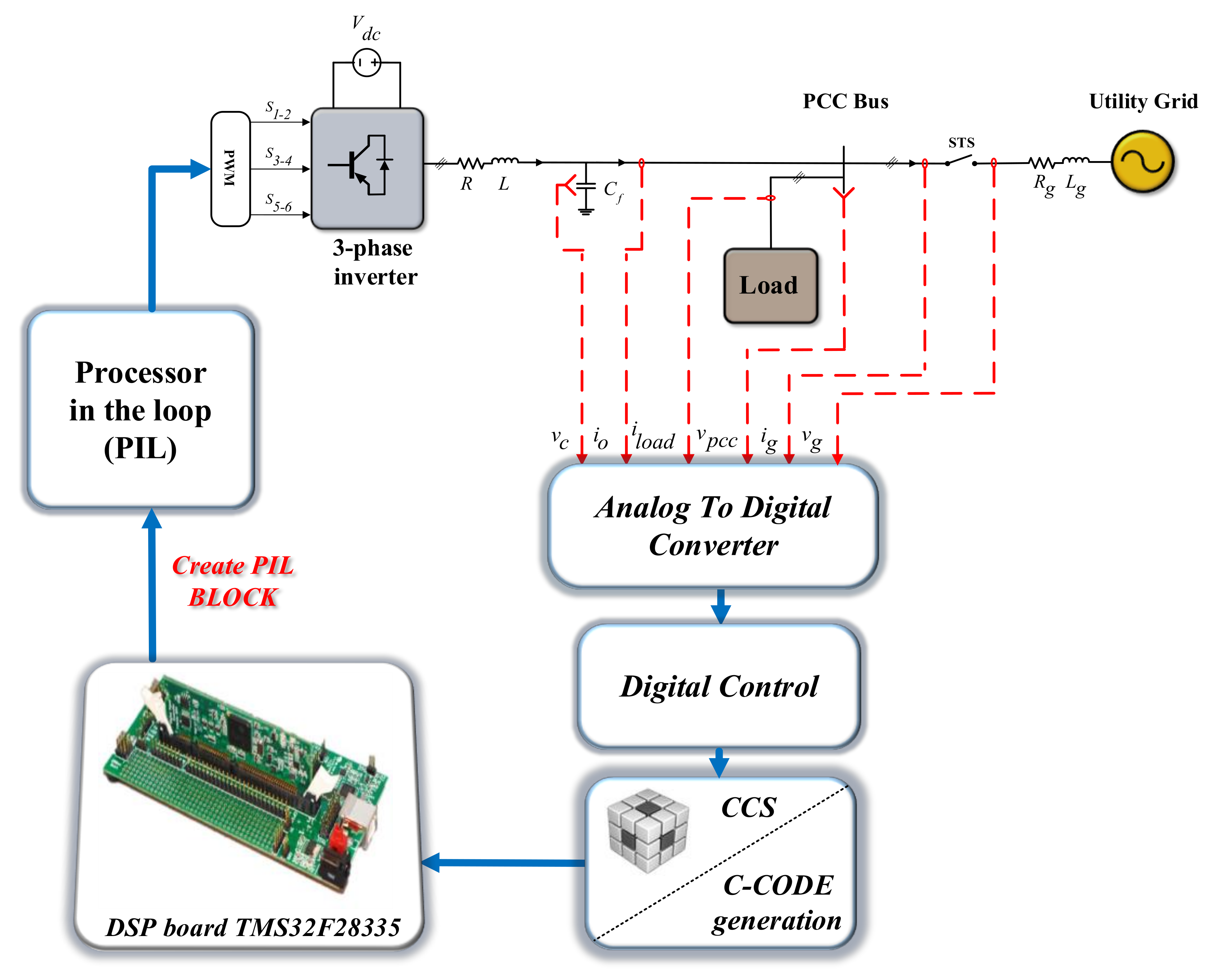
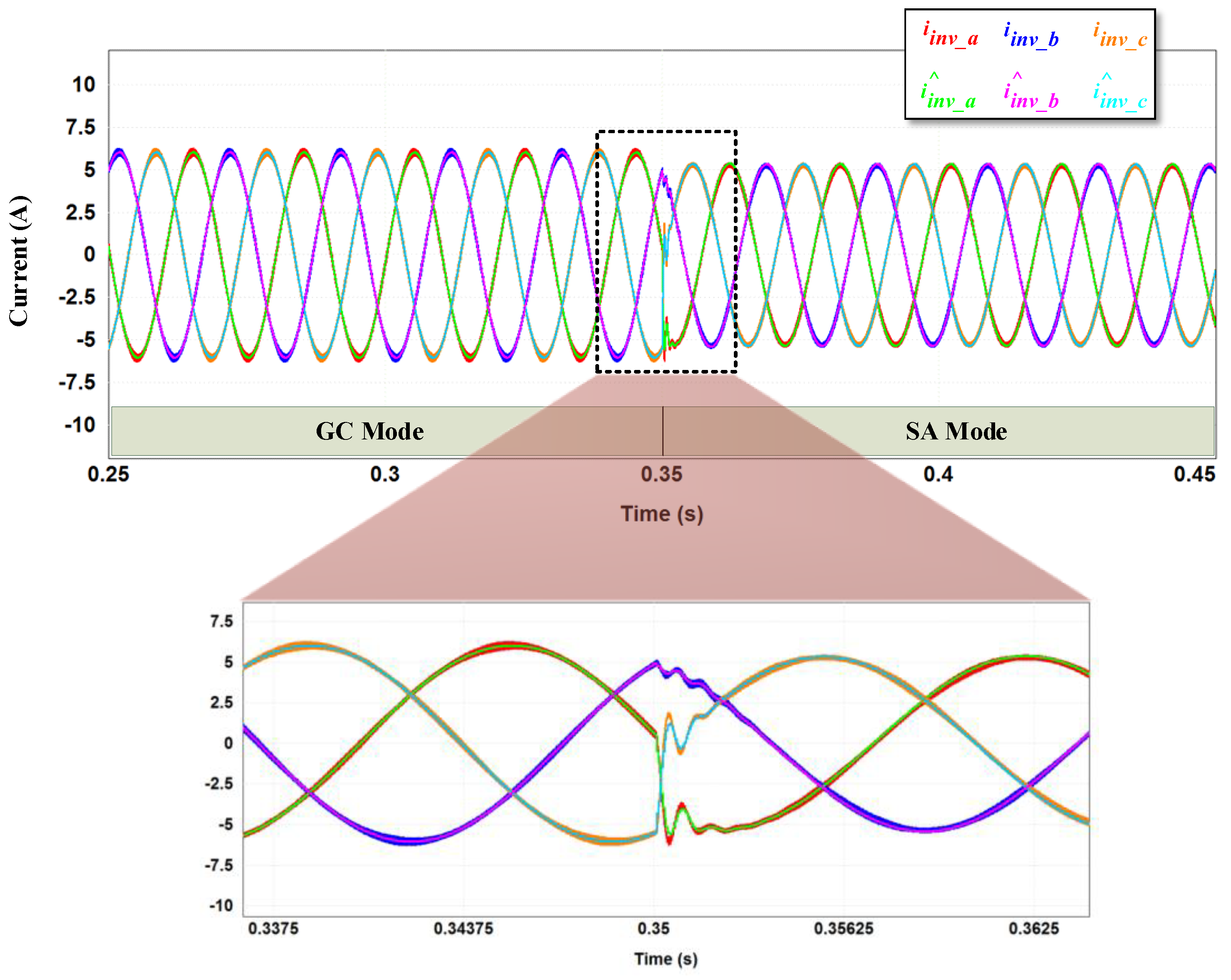


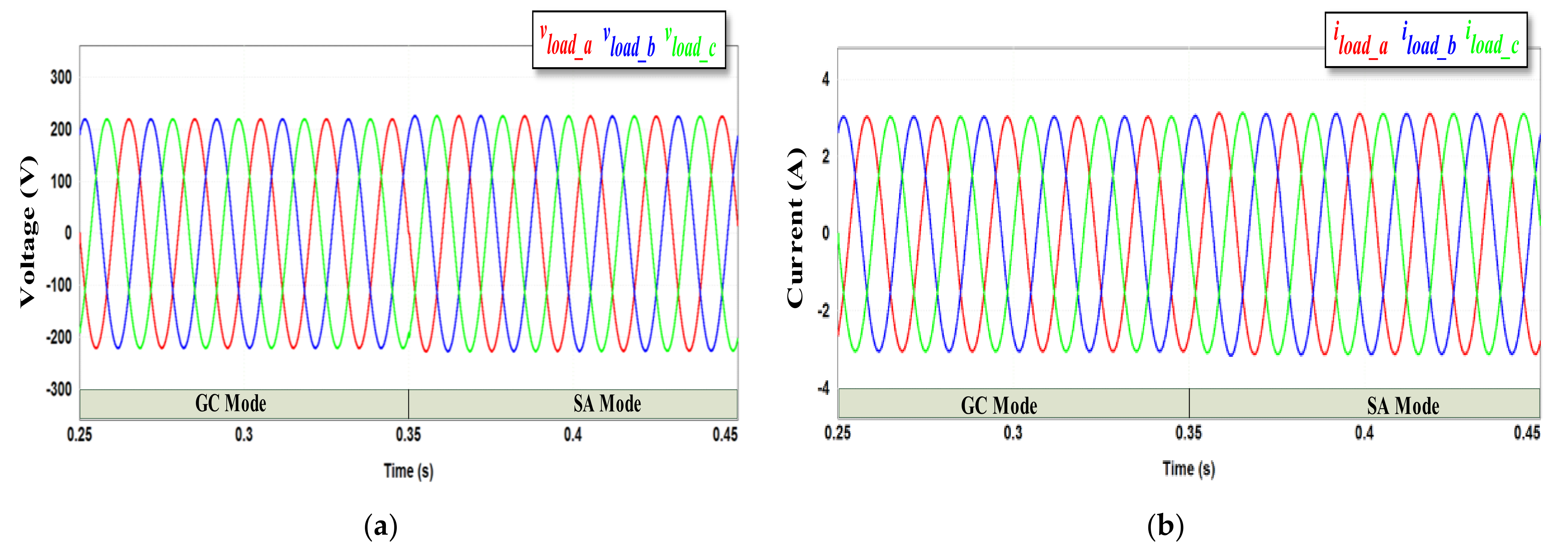

| Parameters | Specification |
|---|---|
| DC-link Voltage | 600 V |
| Grid Voltage (RMS) | 155.56 V |
| Switching Frequency | 20 kHz |
| Sampling Time | 10 μs |
| Grid Impedance | 0.05/0.0016 mH/mΩ |
| Load | 72.5 Ω + 93.4 mH |
| Filter Inductor | 4 mH |
| Filter Capacitor | 60 μF |
| Control Gain ST-SMC (α) | 12 |
| Control Gain ST-SMC (λ) | 3.46 |
| Proportional Gain | |
| Proportional Gain | 0.294/10.5 |
Disclaimer/Publisher’s Note: The statements, opinions and data contained in all publications are solely those of the individual author(s) and contributor(s) and not of MDPI and/or the editor(s). MDPI and/or the editor(s) disclaim responsibility for any injury to people or property resulting from any ideas, methods, instructions or products referred to in the content. |
© 2023 by the authors. Licensee MDPI, Basel, Switzerland. This article is an open access article distributed under the terms and conditions of the Creative Commons Attribution (CC BY) license (https://creativecommons.org/licenses/by/4.0/).
Share and Cite
Aillane, A.; Dahech, K.; Chrifi-Alaoui, L.; Chouder, A.; Damak, T.; Hadjkaddour, A.; Bussy, P. The Design and Processor-In-The-Loop Implementation of a Super-Twisting Control Algorithm Based on a Luenberger Observer for a Seamless Transition between Grid-Connected and Stand-Alone Modes in Microgrids. Energies 2023, 16, 3878. https://doi.org/10.3390/en16093878
Aillane A, Dahech K, Chrifi-Alaoui L, Chouder A, Damak T, Hadjkaddour A, Bussy P. The Design and Processor-In-The-Loop Implementation of a Super-Twisting Control Algorithm Based on a Luenberger Observer for a Seamless Transition between Grid-Connected and Stand-Alone Modes in Microgrids. Energies. 2023; 16(9):3878. https://doi.org/10.3390/en16093878
Chicago/Turabian StyleAillane, Ali, Karim Dahech, Larbi Chrifi-Alaoui, Aissa Chouder, Tarak Damak, Abdelhak Hadjkaddour, and Pascal Bussy. 2023. "The Design and Processor-In-The-Loop Implementation of a Super-Twisting Control Algorithm Based on a Luenberger Observer for a Seamless Transition between Grid-Connected and Stand-Alone Modes in Microgrids" Energies 16, no. 9: 3878. https://doi.org/10.3390/en16093878
APA StyleAillane, A., Dahech, K., Chrifi-Alaoui, L., Chouder, A., Damak, T., Hadjkaddour, A., & Bussy, P. (2023). The Design and Processor-In-The-Loop Implementation of a Super-Twisting Control Algorithm Based on a Luenberger Observer for a Seamless Transition between Grid-Connected and Stand-Alone Modes in Microgrids. Energies, 16(9), 3878. https://doi.org/10.3390/en16093878







